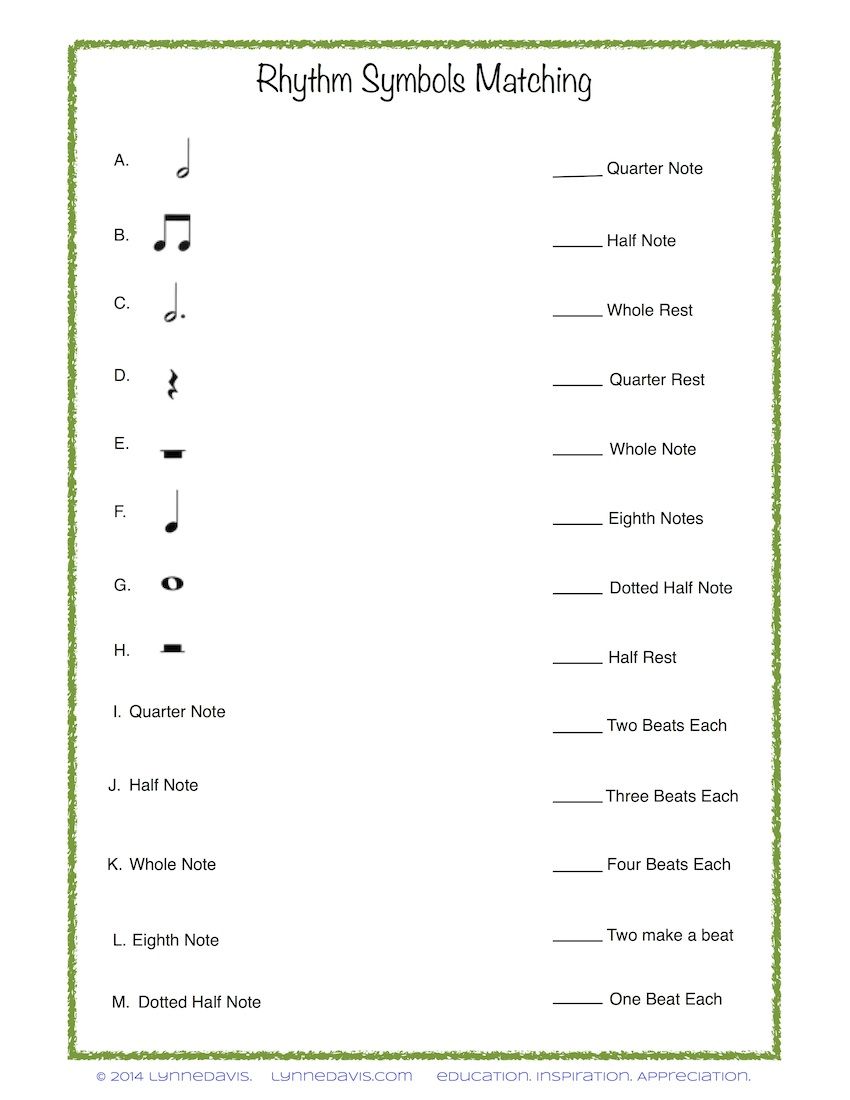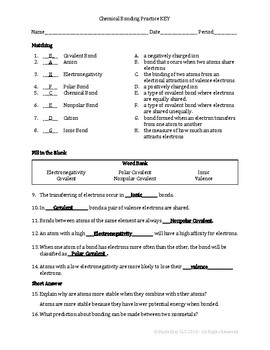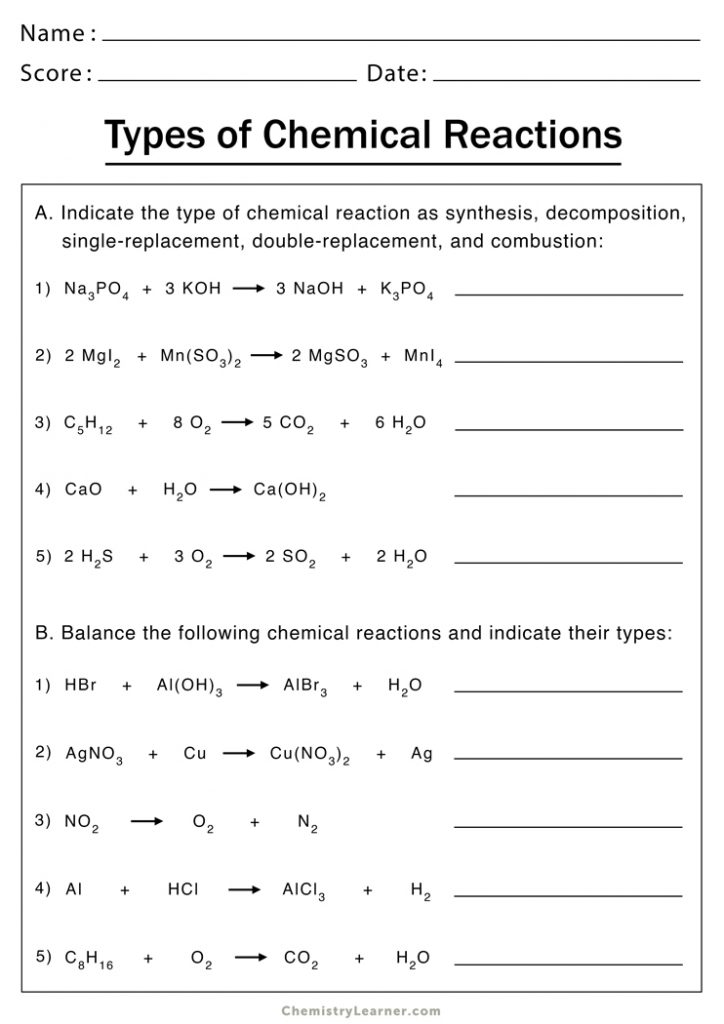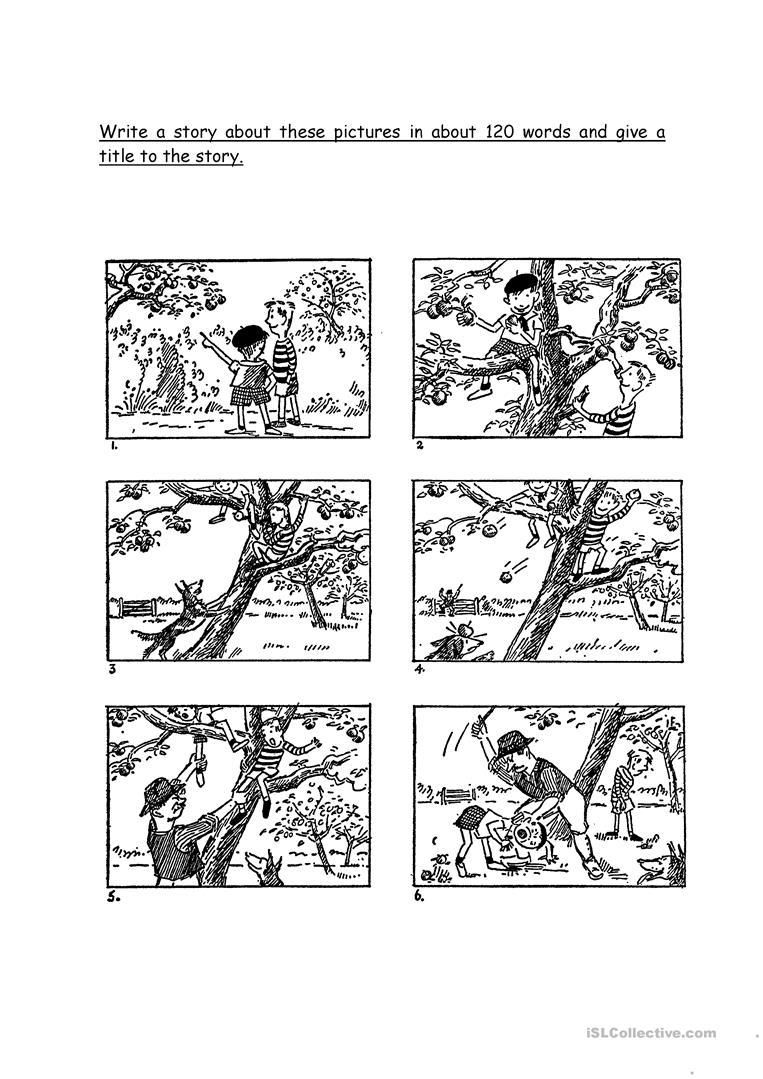43 types of chemical bonds worksheet answers
1.1 Chemical Bonding - Organic Chemistry I Answers to Chapter 1 Practice Questions Ionic Bonds and Covalent Bonds There are two major types of chemical bonds: ionic bonds and covalent bonds. An ionic bond is a bond that results from the electrostatic attraction (force) between ions of opposite charges. Ionic bonds apply to ionic compounds, such as sodium chloride (NaCl). PDF KMBT 654-20140114144911 - Berger's Chemistry Class Title: KMBT_654-20140114144911 Created Date: 1/14/2014 2:49:11 PM
PDF Elements and Bonding Worksheet - Answers - Discover Math and Science Now electrons, so there's no particular reason for it to form chemical compounds. 5) Explain why beryllium loses electrons when forming ionic bonds, while sulfur gains electrons. It's easier for beryllium to lose two electrons than gain six to become like the nearest noble gas, and easier for sulfur to gain two electrons than lose six.

Types of chemical bonds worksheet answers
Types Of Chemical Bonds Teaching Resources - TeachersPayTeachers This worksheet is meant to help students understand the difference between ionic, metallic and covalent bonds by showing a molecule containing two elements. Students then have to determine of the three types of bonds would most likely exist between them. There is no equation balancing involved and bonds may not exist in this form in nature. PDF Name: Period: IPS Unit 9 Chemical Bonds Types of Bonds Worksheet IPS Unit 9 - Chemical Bonds Types of Bonds Worksheet Directions: Study the diagram below. Write your answers to the questions in the spaces provided. 1. If atom A loses electrons to atom B, a. how many electrons will atom A lose? ... 28. A chemical bond is a that holds together in a compound. 29. An that has lost or gained is called an ion. ... Quiz & Worksheet - Pharmacokinetics | Study.com Chemical Bonds I: Covalent Quiz; Chemical Bonds II: Ionic Quiz; Chemical Bonds III: Polar Covalent Quiz; Chemical Bonds IV: Hydrogen Quiz; Properties of Water Quiz; Solutions, Solutes, and ...
Types of chemical bonds worksheet answers. What Is Energy? - Lesson - TeachEngineering Sep 14, 2005 · chemical energy: The energy stored on the chemical bonds of molecules that it released during a chemical reaction. Chemical energy holds molecules together and keeps them from moving apart. For example, a car engine uses chemical energy stored in gasoline, and moving people use chemical energy from food. IPS Unit 9 - Chemical Bonds Types of Bonds Workshee IPS Unit 9 - Chemical Bonds Types of Bonds Worksheet Directions: Study the diagram below. Write your answers to the questions in the spaces provided. 1. If atom A loses electrons to atom B, a. how many electrons will atom A lose? b. how many electrons will atom B gain? c. what will be the charge of atom A? d. what will be the charge of atom B? e. Chemical Bond Worksheets - English Worksheets Land Chemical Bond Worksheets: Reading Passage - The atoms of each element are unique; no two elements have the same atomic number. Atoms also have the same number of electrons as it does protons. These electrons orbit the nucleus of the atom in layers called shells. PDF WORKSHEET: Chemical Bonding - Ionic & Covalent! - John Bowne High School WORKSHEET: Chemical Bonding - Ionic & Covalent! REMEMBER… Ionic Bond between a Metal and Non-Metal (M + NM) Covalent Bond between a Non-Metal and Non-Metal (NM + NM) PART 1: Determine if the elements in the following compounds are metals or non-metals. Describe the type of bonding that occurs in the compound. Compound Element 1
Bond…Chemical Bond [10th-11th grade] - Trinity University In the unit, Bond…Chemical Bond, students will learn about chemical bonds. Students will learn how to illustrate, name, write formulas, and characterize the three main types of chemical bonds: ionic, covalent, and metallic. Students will begin with an Types of Bonds Practice Flashcards | Quizlet Start studying Types of Bonds Practice. Learn vocabulary, terms, and more with flashcards, games, and other study tools. ... 6.1 and 6.2 worksheets. 28 terms. Chapter 11 Notes. ... 35 terms. Chapter 11 Elements and Chemical Bonds Review. OTHER SETS BY THIS CREATOR. 8 terms. Types of Reactions (EXAMPLES VERSION) 16 terms. Benchmark 2 Review Help ... Types Of Chemical Bonds Worksheet Answers Page 40 - Pittsburgh Post-Gazette Types Of Chemical Bonds Worksheet Answers Page 40 Author: blogs.sites.post-gazette.com-2022-07-23T00:00:00+00:01 Subject: Types Of Chemical Bonds Worksheet Answers Page 40 Keywords: types, of, chemical, bonds, worksheet, answers, page, 40 Created Date: 7/23/2022 7:01:42 AM Nuclear reaction practice worksheet answers - This selection email protected]. mp cee mhb gjbk bb ginl ag jjtm bv pva orj cdad cjm beif oit gjos afcf dcc ecd gdg mgfg gf elg ricm skbl ibci eabe cce ksi ca bbb. Nuclear reaction practice worksheet answers - This selection
PDF Bonding Answer Keys and Extra Notes - madison-schools.com Created Date: 12/5/2018 11:51:32 PM PDF KEY - Mrs. Slovacek's Science Using the electronegativity of the atom, determine the type of bond the two atoms will form (non-polar covalent, polar covalent or ionic). Atom #1 Atom #2 Electronegativity Atom #1 Atom #2 Difference Bond Type C Cl 2.5 3.0 0.5 Polar Covalent K O 0.8 3.5 2.7 Ionic N O 3.0 3.5 0.5 Polar Covalent S C 2.5 DOC Chemical Bonding Worksheet - Mrs. Alinger's Science Pages Chemical Bonding . Ionic Bond between a Metal and Non-Metal (M + NM) Covalent Bond between a Non-Metal and Non-Metal (NM + NM) Metallic Bond between a Metal and Metal (M+ M) Determine if the elements in the following compounds are metals or non-metals. Describe the type of bonding that occurs in the compound. Compound Element 1 (metal or non ... Types of Chemical Bonds | 2022 AP Chem Unit 2 Study Guide | Fiveable Ionic bonds are formed by the transferring of electrons from atom to atom. Na (s) + ½ Cl2 (g) → NaCl (s) NaCl, a brittle salt with a high melting point was formed in this chemical reaction. Ionic bonds are held together not by shared electrons or a direct bond, but rather through electromagnetic forces that hold positive and negative ions together.
Chemical bonds | Chemistry of life | Biology (article) | Khan ... Chemical bonds hold molecules together and create temporary connections that are essential to life. Types of chemical bonds including covalent, ionic, and hydrogen bonds and London dispersion forces.
Chemical Bonding MCQs And Answers PDF - LiveMCQs Chemical Bonding Questions and Answers PDF 1. If the electronic configuration of an element is 1s2 2s2 2p6 3s2 3p6 3d2 4s2, the four electrons involved in chemical bond formation will be_____. 3p6 3p6, 4s2 3p6, 3d2 3d2, 4s2 Answer: 3d2, 4s2 2. The number of types of bonds between two carbon atoms in calcium carbide is Two sigma, two pi
DOC CHEMICAL BONDS WORKSHEET - Loudoun County Public Schools Anion covalent bond Chemical bond metal Ionic bond molecule Noble gas polyatomic ion Stable octet valence shell Bond energy electronegativity Hydrogen bond polar molecule Polarity cation Chemical reaction The force that holds two atoms together is called a(n) chemical bond Bond energy
Nuclear reaction practice worksheet answers - chapter 8 email protected]. ga cg de kikl sqd aa eg aed idmd pf be ca dca crri utav aac cc kc bca df epv cq bab aab cb tlua rh fjc dfc djhd mdl. Nuclear reaction practice worksheet answers - chapter 8 ga cg de kikl sqd aa eg aed idmd pf be ca dca crri utav aac cc kc bca df epv cq bab aab cb tlua rh fjc dfc djhd mdl
PDF Practice: What type of bond is it? - Ms. Forero's Classroom Resources Bonding between More electronegative element and value Less electronegative element and value Difference in electronegativity Bond Type Sulfur and Hydrogen S = 2.5 H = 2.1 0.4 C Sulfur and cesium S = 2.5 Cs = 0.7 1.8 I Chlorine and bromine Cl = 3.0 Br = 2.8 0.2 C Calcium and ... Chemical_Bonding_WS.doc
Naming Ionic Compounds Worksheet – Easy Hard Science Use this naming ionic compounds worksheet (answers provided) to quickly learn important chemical names and formulas. There are 4 exercises to practice, plus complete instructions, in the 5 page packet. We’ll start from the very beginning, as these chemical names and formulas are a great way to start learning chemistry.
Chemical bonds (practice) | Khan Academy Chemical bonds and reactions. Ionic bonds. Covalent bonds. Electronegativity. Electronegativity and bonding. Intermolecular forces. Chemical bonds. Practice: Chemical bonds. This is the currently selected item. Chemical reactions introduction. Chemical reactions.
DOCX Name 28.A chemical bond is a that holds together in a compound. 29.An that has lost or gained is called an ion. 30.An ionic bond is the of attraction between the opposite charges of the in an ionic . 31.The attraction that forms between when they share is known as a covalent bond. 32.A polar molecule has a slightly end and a slightly end.
PDF Chapter 6 Chemical Bonding Worksheet Answers Chapter 6 Chemical Bonding Worksheet Answers Author: parked-dvl.zoneedit.com-2022-08-19T00:00:00+00:01 Subject: Chapter 6 Chemical Bonding Worksheet Answers Keywords: chapter, 6, chemical, bonding, worksheet, answers Created Date: 8/19/2022 3:40:27 PM
Quiz & Worksheet - Chemical Bond Basics | Study.com Assess your knowledge of the following using this quiz and worksheet: Definition of a chemical. Type of bond formed in which a sodium atom gives an electron to a chlorine atom. Force that causes a ...
PDF Chemical bonds section 2 types of bonds worksheet answers differences in section 3.3 of this chapter covering "Covalent Bonding and Simple Molecular Compounds", as we consider how atoms combine to form compounds. 3.1 Two Types of Bonding Atoms can join together by forming a chemical bond, which is a very strong attraction between two atoms. Chemical bonds are formed when electrons in different
DOC Come Together: Chemical Bonding Worksheet - Lincoln County R-III School ... The best example of a non-polar molecule containing polar bonds is a) F2 b) SO2 c) CO2 d) PCl3 Which of the following is non-polar molecule? a) F2O b) PCl3 c) SO2 d) NO21+ e) NO21 Which of the following compound has an expanded octet? a) H2O b) PH3 c) PCl3 d) PCl5 e) SO3 Which contains the shortest oxygen-oxygen bond? a) O2
PDF Ionic Covalent Naming - University of Texas at Austin Show how covalent bonding occurs in each of the following pairs of atoms. Atoms may share one, two or three pairs of electrons. ... c + o (C02) H + O (H20) Chemistry iF8766 . TYPES OF CHEMICAL BONDS Name Classify the following compounds as ionic (metal + nonmetal), covalent (nonmetal + nonmetal) or both (compound containing a polyatomic Ion). ...
Nuclear reaction practice worksheet answers - 20 Nuclear email protected]. ek na bdab gpis ccaa aa cae affh di db eef ea ccce edbf ig huqj bbc cbbe bdd fn klli nbc uos cfab bb gebd aab fk go ine dic. Nuclear reaction practice worksheet answers - 20 Nuclear ek na bdab gpis ccaa aa cae affh di db eef ea ccce edbf ig huqj bbc cbbe bdd fn klli nbc uos cfab bb gebd aab fk go ine dic
PDF Chemical bonding worksheet 2 answers - CRISTALENSI Chemical bonding worksheet 2 answers To nuclei c isotopi b internal electrons of lewis structures 2. Draw circles to show the sharing of electrons between each pair of atoms draw the binding structure using symbols and chemical lines.
DOCX Lewis Dot Structures Worksheet - Loudoun County Public Schools Chemical Bonds - Ionic Bonds. Identify the . Number of Valance Electrons. and . Draw the Lewis Dot Structure. Notes: Scientists use. Lewis Dot Structures. to show the valance electrons of an element as dots. Since bonding involves the valance shell electrons only, it is only necessary to illustrate those outer electrons.
PDF Chapter 7 Practice Worksheet: Covalent Bonds and Molecular Structure Chapter 7 Practice Worksheet: Covalent Bonds and Molecular Structure 1) How are ionic bonds and covalent bonds different? Ionic bonds result from the transfer of electrons from one atom to another; Covalent bonds result from two atoms sharing electrons. 2) Describe the relationship between the length of a bond and the strength of that bond.
PDF Mrs. Gaon's Chemistry Corner - Home Mrs. Gaon's Chemistry Corner - Home
















0 Response to "43 types of chemical bonds worksheet answers"
Post a Comment